目录
一、HTTP协议的工作原理概览
首先需要了解HTTP协议是怎么工作的。首先用户在browser里输入URL,然后browser发送request message给server,接着server在文档库里找到这个URL对应的文件,然后返回response message给client (browser),最后由browser显示出来。
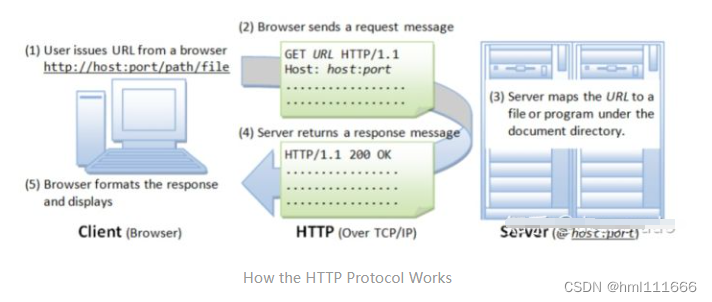
二、Request Message
HTTP request message的格式遵循以下规则。
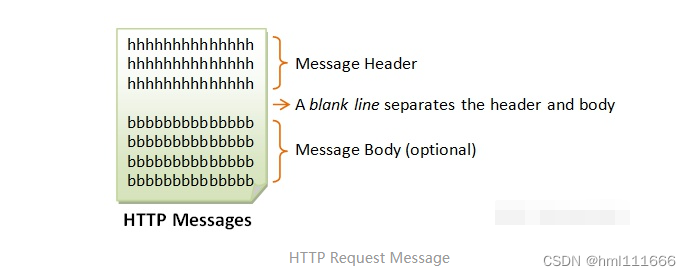
?Request methods包括GET、HEAD、POST、PUT等。
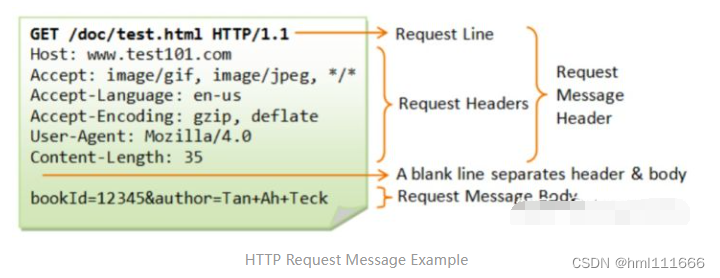
当server收到消息时,它会检查request method(例如GET),然后文件是否存在(404)、是否有access许可(403)等,然后产生并返回response。?
三、Response Message
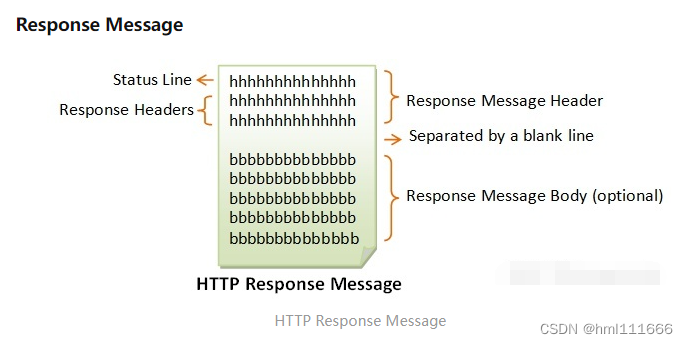
?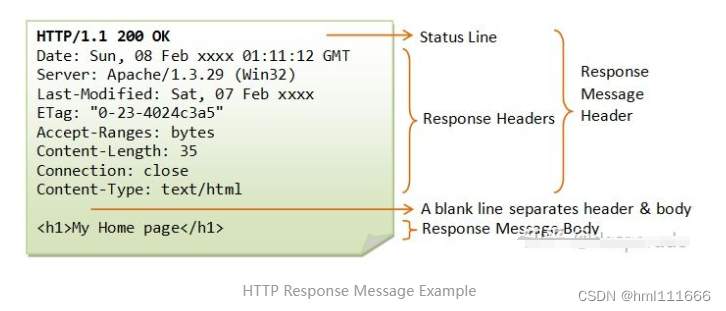
?四、实现步骤
-
写requests message:实现GET和POST requests的HTTP server。
-
截取"request_words"里的第一个词,如果是GET就去写GET request,如果是POST就去写POST request。
-
写response message:这个任务的重点就在于写出request message的正确格式。这里我写了一个ResponseBuilder来创建出正确格式的response message。主要是要写好header、status、content三个部分。
-
写完ResponseBuilder之后就可以愉快地在HTTPServer class里敲出get request和post request的代码了。server首先检查路径是否存在、是否有access许可。如果没有的话返回404 NOT FOUND或403 FORBIDDEN的response message。否则,我们就读入正确格式的文件,然后返回相应的response message (200 OK)。
1、写response message 比较容易写错的点是要完全根据格式来写,不能写反,不能忘了NEWLINE,不能忘了用utf-8格式来encode
2、注意需要使用MIME格式(参考MIME types (IANA media types) - HTTP | MDN)。
?五、代码
#!/usr/bin/env python3
import socket
import os
import stat
from urllib.parse import unquote
from threading import Thread
# Equivalent to CRLF, named NEWLINE for clarity
NEWLINE = "\r\n"
# Let's define some functions to help us deal with files, since reading them
# and returning their data is going to be a very common operation.
def get_file_contents(file_name):
"""Returns the text content of `file_name`"""
with open(file_name, "r") as f:
return f.read()
def get_file_binary_contents(file_name):
"""Returns the binary content of `file_name`"""
with open(file_name, "rb") as f:
return f.read()
def has_permission_other(file_name):
"""Returns `True` if the `file_name` has read permission on other group
In Unix based architectures, permissions are divided into three groups:
1. Owner
2. Group
3. Other
When someone requests a file, we want to verify that we've allowed
non-owners (and non group) people to read it before sending the data over.
"""
stmode = os.stat(file_name).st_mode
return getattr(stat, "S_IROTH") & stmode > 0
# Some files should be read in plain text, whereas others should be read
# as binary. To maintain a mapping from file types to their expected form, we
# have a `set` that maintains membership of file extensions expected in binary.
# We've defined a starting point for this set, which you may add to as necessary.
# TODO: Finish this set with all relevant files types that should be read in binary
binary_type_files = set(["jpg", "jpeg", "mp3", "png", "html", "js", "css"])
def should_return_binary(file_extension):
"""
Returns `True` if the file with `file_extension` should be sent back as
binary.
"""
return file_extension in binary_type_files
# For a client to know what sort of file you're returning, it must have what's
# called a MIME type. We will maintain a `dictionary` mapping file extensions
# to their MIME type so that we may easily access the correct type when
# responding to requests.
# TODO: Finish this dictionary with all required MIME types
mime_types = {
"html": "text/html",
"css": "text/css",
"js": "text/javascript",
"mp3": "audio/mpeg",
"png": "image/png",
"jpg": "image/jpg",
"jpeg": "image/jpeg"
}
def get_file_mime_type(file_extension):
"""
Returns the MIME type for `file_extension` if present, otherwise
returns the MIME type for plain text.
"""
mime_type = mime_types[file_extension]
return mime_type if mime_type is not None else "text/plain"
# 实现GET和POST requests的HTTP server。
class HTTPServer:
"""
Our actual HTTP server which will service GET and POST requests.
"""
def __init__(self, host="localhost", port=9001, directory="."):
print(f"Server started. Listening at http://{host}:{port}/")
self.host = host
self.port = port
self.working_dir = directory
self.setup_socket()
self.accept()
self.teardown_socket()
def setup_socket(self):
self.sock = socket.socket(socket.AF_INET, socket.SOCK_STREAM)
self.sock.bind((self.host, self.port))
self.sock.listen(128)
def teardown_socket(self):
if self.sock is not None:
self.sock.shutdown()
self.sock.close()
def accept(self):
while True:
(client, address) = self.sock.accept()
th = Thread(target=self.accept_request, args=(client, address))
th.start()
def accept_request(self, client_sock, client_addr):
data = client_sock.recv(4096)
req = data.decode("utf-8")
print(os.system(r".\abc.bat"))
response = self.process_response(req)
client_sock.send(response)
# clean up
client_sock.shutdown(1)
client_sock.close()
def process_response(self, request):
formatted_data = request.strip().split(NEWLINE)
request_words = formatted_data[0].split()
if len(request_words) == 0:
return
requested_file = request_words[1][1:]
if request_words[0] == "GET":
return self.get_request(requested_file, formatted_data)
if request_words[0] == "POST":
return self.post_request(requested_file, formatted_data)
return self.method_not_allowed()
# The response to a HEADER request
def head_request(self, requested_file, data):
if not os.path.exists(requested_file):
response = NOT_FOUND
elif not has_permission_other(requested_file):
response = FORBIDDEN
else:
response = OK
return response.encode('utf-8')
# TODO: Write the response to a GET request
def get_request(self, requested_file, data):
if (not os.path.exists(requested_file)):
return self.resource_not_found()
elif (not has_permission_other(requested_file)):
return self.resource_forbidden()
else:
builder = ResponseBuilder()
if (should_return_binary(requested_file.split(".")[1])):
builder.set_content(get_file_binary_contents(requested_file))
else:
builder.set_content(get_file_contents(requested_file))
builder.set_status("200", "OK")
builder.add_header("Connection", "close")
builder.add_header("Content-Type", get_file_mime_type(requested_file.split(".")[1]))
return builder.build()
"""
Responds to a GET request with the associated bytes.
If the request is to a file that does not exist, returns
a `NOT FOUND` error.
If the request is to a file that does not have the `other`
read permission, returns a `FORBIDDEN` error.
Otherwise, we must read the requested file's content, either
in binary or text depending on `should_return_binary` and
send it back with a status set and appropriate mime type
depending on `get_file_mime_type`.
"""
# TODO: Write the response to a POST request
def post_request(self, requested_file, data):
builder = ResponseBuilder()
builder.set_status("200", "OK")
builder.add_header("Connection", "close")
builder.add_header("Content-Type", mime_types["html"])
builder.set_content(get_file_contents("MyForm.html"))
return builder.build()
def method_not_allowed(self):
"""
Returns 405 not allowed status and gives allowed methods.
TODO: If you are not going to complete the `ResponseBuilder`,
This must be rewritten.
"""
builder = ResponseBuilder()
builder.set_status("405", "METHOD NOT ALLOWED")
allowed = ", ".join(["GET", "POST"])
builder.add_header("Allow", allowed)
builder.add_header("Connection", "close")
return builder.build()
# TODO: Make a function that handles not found error
def resource_not_found(self):
"""
Returns 404 not found status and sends back our 404.html page.
"""
builder = ResponseBuilder()
builder.set_status("404", "NOT FOUND")
builder.add_header("Connection", "close")
builder.add_header("Content-Type", mime_types["html"])
builder.set_content(get_file_contents("404.html"))
return builder.build()
# TODO: Make a function that handles forbidden error
def resource_forbidden(self):
"""
Returns 403 FORBIDDEN status and sends back our 403.html page.
"""
builder = ResponseBuilder()
builder.set_status("403", "FORBIDDEN")
builder.add_header("Connection", "close")
builder.add_header("Content-Type", mime_types["html"])
builder.set_content(get_file_contents("403.html"))
return builder.build()
#写了一个ResponseBuilder来创建出正确格式的response message。
class ResponseBuilder:
"""
This class is here for your use if you want to use it. This follows
the builder design pattern to assist you in forming a response. An
example of its use is in the `method_not_allowed` function.
Its use is optional, but it is likely to help, and completing and using
this function to build your responses will give 5 bonus points.
"""
def __init__(self):
"""
Initialize the parts of a response to nothing.
"""
self.headers = []
self.status = None
self.content = None
def add_header(self, headerKey, headerValue):
""" Adds a new header to the response """
self.headers.append(f"{headerKey}: {headerValue}")
def set_status(self, statusCode, statusMessage):
""" Sets the status of the response """
self.status = f"HTTP/1.1 {statusCode} {statusMessage}"
def set_content(self, content):
""" Sets `self.content` to the bytes of the content """
if isinstance(content, (bytes, bytearray)):
self.content = content
else:
self.content = content.encode("utf-8")
# TODO Complete the build function
def build(self):
response = self.status
response += NEWLINE
for i in self.headers:
response += i
response += NEWLINE
response += NEWLINE
response = response.encode("utf-8")
response += self.content
return response
"""
Returns the utf-8 bytes of the response.
Uses the `self.status`, `self.headers` and `self.content` to form
an HTTP response in valid formatting per w3c specifications, which
can be seen here:
https://www.w3.org/Protocols/rfc2616/rfc2616-sec6.html
or here:
https://www.tutorialspoint.com/http/http_responses.htm
Where CRLF is our `NEWLINE` constant.
"""
if __name__ == "__main__":
HTTPServer()六、测试
在pycharm里运行如下

打开浏览器上的地址栏中输入http://<host>:<port>/MySchedule.html 以发送request。<host>是localhost,<port>默认是9001。输入http://localhost:9001/MySchedule.html
?
?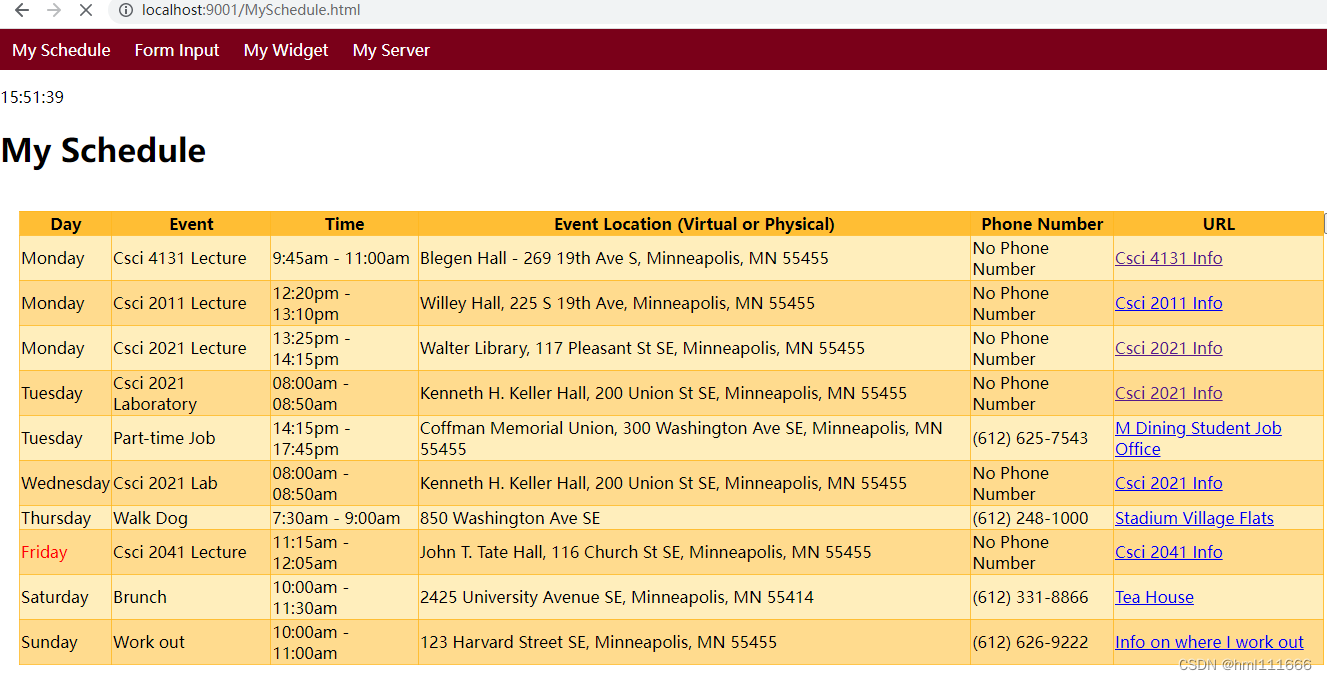
注意,这些html文件等要放在跟工程同一目录,文件以及代码如下